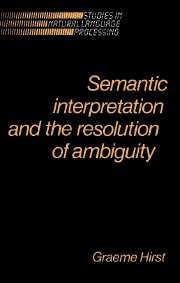Book contents
9 - Speculations, Partially Baked Ideas, and Exercises for the Reader
Published online by Cambridge University Press: 18 December 2009
Summary
When there is light at the end of the tunnel, order more tunnel.
—AnonymousBut in our enthusiasm, we could not resist a radical overhaul of the system, in which all of its major weaknesses have been exposed, analyzed, and replaced with new weaknesses.
—Bruce LeverettThe research I have described in this book necessarily leaves unanswered many questions, big and small. Many sections, especially 3.8, 5.3.6, 5.4, and 7.4 have discussed things left undone by Absity, Polaroid Words, and the Semantic Enquiry Desk. In this chapter, I list a number of other open questions, partially baked ideas, and wild speculations, sometimes with my thoughts on how they might be answered or developed. Some could be dissertation topics; others may be good subjects for a term paper or course project. Several are psycholinguistic experiments. At the start of each question (if appropriate) I give in brackets the section or sections of this book in which the matter is discussed.
The representation of knowledge
Exercise 1.1 [1.1.2,1.3.1,5.2,5.6.3] Could a non-discrete representation of knowledge be developed for AI? Such a representation would be able to handle close similarities and differences, such as the head of a pin compared with the head of a hammer. Consider the possibility of pseudo-continuous representations that are to discrete representations as floating-point numbers are to integers. Candidates to consider include some kind of network of neuron-like nodes (cf. Feldman and Ballard 1982; Feldman 1985), a value-passing machine such as Fahlman, Hinton and Sejnowski's (1983) Thistle system, and a simulated-annealing or Boltzmann network (Kirkpatrick, Gelatt and Vecchi 1983; Fahlman, Hinton and Sejnowski 1983; Smolensky 1983) (see also exercise 4.8).
- Type
- Chapter
- Information
- Semantic Interpretation and the Resolution of Ambiguity , pp. 202 - 222Publisher: Cambridge University PressPrint publication year: 1987



